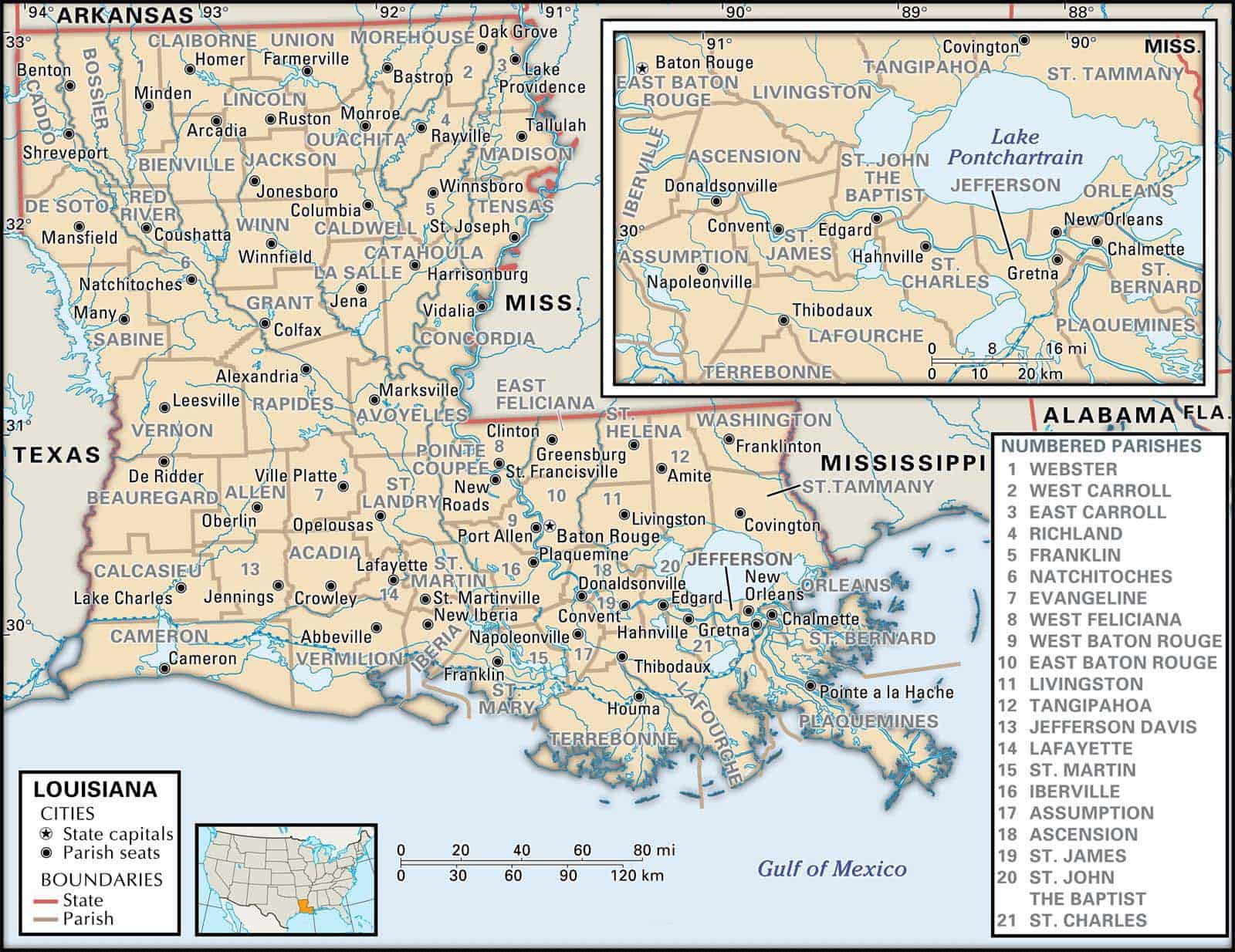
Maps of Louisiana are a very helpful tool when it comes to ancestral and family history research, particularly in the case that you live far from where your ancestor was living.
Because Louisiana’s political boundaries have sometimes changed over the years, historic maps can be critical in helping you uncover the exact location of your ancestor’s hometown, what land they owned, who their neighbors were, and a lot more besides.
Referring to maps of Louisiana is an outstanding way of getting started with your research since they give helpful information and facts quickly, and present them in a clear and understandable format.
Louisiana’s 10 largest cities are New Orleans, Baton Rouge, Shreveport, Metairie, Lafayette, Lake Charles, Kenner, Bossier City, Monroe, and Alexandria.
Learn more historical facts about Louisiana parishes here.
Interactive Map of Louisiana Parish Formation History
AniMap Plus 3.0, with the permission of the Goldbug Company
List of Every Louisiana Parish
Acadia Parish
Established in 1886, Acadia Parish has a population of around 62,000 people. It is located in southwestern Louisiana and is known for its agricultural industry, particularly rice and crawfish.
Allen Parish
Allen Parish was established in 1912 and has a population of around 25,000 people. Located in central Louisiana, it is known for its forests, hunting, and fishing, and the Coushatta Indian Reservation.
Ascension Parish
Established in 1807, Ascension Parish has a population of around 125,000 people. It is located in southeastern Louisiana and is known for its petrochemical industry and historic antebellum homes.
Assumption Parish
Assumption Parish was established in 1807 and has a population of around 22,000 people. Located in southeastern Louisiana, it is known for its sugarcane and oil industries, as well as the Bayou Lafourche.
Avoyelles Parish
Established in 1807, Avoyelles Parish has a population of around 41,000 people. Located in central Louisiana, it is known for its diverse cultural heritage, historic architecture, and Cajun food.
Beauregard Parish
Beauregard Parish was established in 1912 and has a population of around 38,000 people. Located in southwestern Louisiana, it is known for its timber industry, hunting and fishing, and the city of DeRidder.
Bienville Parish
Established in 1848, Bienville Parish has a population of around 13,000 people. Located in northwestern Louisiana, it is known for its scenic beauty, outdoor recreation, and the historic town of Arcadia.
Bossier Parish
Bossier Parish was established in 1843 and has a population of around 136,000 people. Located in northwestern Louisiana, it is known for its military presence, gaming industry, and the city of Bossier City.
Caddo Parish
Established in 1838, Caddo Parish has a population of around 251,000 people. Located in northwestern Louisiana, it is known for its cultural diversity, music, and the city of Shreveport.
Calcasieu Parish
Calcasieu Parish was established in 1840 and has a population of around 206,000 people. Located in southwestern Louisiana, it is known for its petrochemical industry, Lake Charles, and the Creole Nature Trail.
Caldwell Parish
Established in 1838, Caldwell Parish has a population of around 10,000 people. Located in north-central Louisiana, it is known for its agricultural industry, particularly cotton and soybeans.
Cameron Parish
Cameron Parish was established in 1870 and has a population of around 7,000 people. Located in southwestern Louisiana, it is known for its fishing industry, Creole Nature Trail, and the coastal town of Cameron.
Catahoula Parish
Established in 1808, Catahoula Parish has a population of around 9,000 people. Located in central Louisiana, it is known for its outdoor recreation opportunities, particularly hunting and fishing.
Claiborne Parish
Claiborne Parish was established in 1828 and has a population of around 16,000 people. Located in northwestern Louisiana, it is known for its historic sites, such as the Louisiana State Arboretum and the Bienville Parish Courthouse.
Concordia Parish
Established in 1807, Concordia Parish has a population of around 19,000 people. Located in northeastern Louisiana, it is known for its historic architecture, particularly in the town of Vidalia.
DeSoto Parish
DeSoto Parish was established in 1843 and has a population of around 27,000 people. Located in northwestern Louisiana, it is known for its historic sites, such as the Mansfield State Historic Site and the Cane River National Heritage Area.
East Baton Rouge Parish
Established in 1810, East Baton Rouge Parish has a population of around 440,000 people. Located in southeastern Louisiana, it is known for its capital city, Baton Rouge, and its vibrant arts and culture scene.
East Carroll Parish
East Carroll Parish was established in 1877 and has a population of around 7,000 people. Located in northeastern Louisiana, it is known for its agriculture, particularly cotton and soybeans.
East Feliciana Parish
Established in 1824, East Feliciana Parish has a population of around 20,000 people. Located in southeastern Louisiana, it is known for its historic sites, such as the Rosedown Plantation State Historic Site and the Centenary State Historic Site.
Evangeline Parish
Evangeline Parish was established in 1910 and has a population of around 33,000 people. Located in central Louisiana, it is known for its Cajun culture and its annual crawfish festival.
Franklin Parish
Established in 1843, Franklin Parish has a population of around 20,000 people. Located in northeastern Louisiana, it is known for its agriculture, particularly cotton and sweet potatoes.
Grant Parish
Grant Parish was established in 1869 and has a population of around 22,000 people. Located in central Louisiana, it is known for its fishing and hunting opportunities, as well as its historic sites, such as the Forts Randolph and Buhlow State Historic Site.
Iberia Parish
Established in 1868, Iberia Parish has a population of around 70,000 people. Located in southeastern Louisiana, it is known for its Cajun and Creole culture, as well as its sugar cane and oil industries.
Iberville Parish
Iberville Parish was established in 1807 and has a population of around 32,000 people. Located in southeastern Louisiana, it is known for its historic sites, such as the Bayou Plaquemine Waterfront Park and the Iberville Parish Courthouse.
Jackson Parish
Established in 1845, Jackson Parish has a population of around 15,000 people. Located in north-central Louisiana, it is known for its outdoor recreation opportunities, such as hunting and fishing.
Jefferson Davis Parish
Jefferson Davis Parish was established in 1912 and has a population of around 31,000 people. Located in southwestern Louisiana, it is known for its agricultural industry, particularly rice and soybeans, as well as its historic sites, such as the Welsh Museum.
Jefferson Parish
Established in 1825, Jefferson Parish has a population of around 435,000 people. Located in southeastern Louisiana, it is known for its suburban communities, such as Metairie and Kenner, and its proximity to New Orleans.
La Salle Parish
La Salle Parish was established in 1910 and has a population of around 14,000 people. Located in central Louisiana, it is known for its agricultural industry, particularly soybeans and cotton.
Lafayette Parish
Established in 1823, Lafayette Parish has a population of around 245,000 people. Located in southwestern Louisiana, it is known for its Cajun and Creole culture, its thriving music scene, and the city of Lafayette.
Lafourche Parish
Lafourche Parish was established in 1807 and has a population of around 97,000 people. Located in southeastern Louisiana, it is known for its fishing industry, as well as its historic sites, such as the Bayou Lafourche Folklife and Heritage Museum.
Lincoln Parish
Established in 1873, Lincoln Parish has a population of around 47,000 people. Located in north-central Louisiana, it is known for its educational institutions, such as Louisiana Tech University.
Livingston Parish
Livingston Parish was established in 1832 and has a population of around 145,000 people. Located in southeastern Louisiana, it is known for its suburban communities, such as Denham Springs and Livingston, and its proximity to Baton Rouge.
Madison Parish
Established in 1838, Madison Parish has a population of around 11,000 people. Located in northeastern Louisiana, it is known for its agricultural industry, particularly cotton.
Morehouse Parish
Morehouse Parish was established in 1844 and has a population of around 24,000 people. Located in northeastern Louisiana, it is known for its agriculture, particularly cotton, as well as its historic sites, such as the Bastrop Opera House.
Natchitoches Parish
Established in 1807, Natchitoches Parish has a population of around 38,000 people. Located in northwestern Louisiana, it is known for its historic sites, such as the Cane River Creole National Historical Park, and its annual Christmas Festival.
Orleans Parish
Orleans Parish was established in 1807 and has a population of around 390,000 people. Located in southeastern Louisiana, it is known for its vibrant music, food, and culture scene, as well as its historic sites, such as the French Quarter and the St. Louis Cathedral.
Ouachita Parish
Established in 1807, Ouachita Parish has a population of around 160,000 people. Located in northeastern Louisiana, it is known for its educational institutions, such as the University of Louisiana at Monroe, and its outdoor recreation opportunities, such as fishing and hunting.
Plaquemines Parish
Plaquemines Parish was established in 1807 and has a population of around 23,000 people. Located in southeastern Louisiana, it is known for its fishing industry, as well as its historic sites, such as Fort Jackson and the Plaquemines Parish Courthouse.
Pointe Coupee Parish
Established in 1807, Pointe Coupee Parish has a population of around 21,000 people. Located in southeastern Louisiana, it is known for its historic sites, such as the False River and the Julien Poydras Museum and Arts Center.
Rapides Parish
Rapides Parish was established in 1807 and has a population of around 132,000 people. Located in central Louisiana, it is known for its outdoor recreation opportunities, such as fishing and hunting, as well as its historic sites, such as the Alexandria Museum of Art.
Red River Parish
Established in 1871, Red River Parish has a population of around 8,400 people. Located in northwestern Louisiana, it is known for its historic sites, such as the Red River Parish Courthouse and the Martin Homeplace.
Richland Parish
Richland Parish was established in 1868 and has a population of around 20,000 people. Located in northeastern Louisiana, it is known for its agricultural industry, particularly cotton and corn.
Sabine Parish
Established in 1843, Sabine Parish has a population of around 23,000 people. Located in northwestern Louisiana, it is known for its outdoor recreation opportunities, such as hunting and fishing, as well as its historic sites, such as the Fort Jesup State Historic Site.
St. Bernard Parish
St. Bernard Parish was established in 1807 and has a population of around 45,000 people. Located in southeastern Louisiana, it is known for its fishing industry and its historic sites, such as the Chalmette Battlefield and the Pakenham Oaks.
St. Charles Parish
Established in 1807, St. Charles Parish has a population of around 54,000 people. Located in southeastern Louisiana, it is known for its petrochemical industry, as well as its historic sites, such as Destrehan Plantation and the German Coast Farmers’ Market.
St. Helena Parish
St. Helena Parish was established in 1810 and has a population of around 10,000 people. Located in southeastern Louisiana, it is known for its rural communities and its historic sites, such as the St. Helena Parish Courthouse and the Immaculate Conception Church.
St. James Parish
Established in 1807, St. James Parish has a population of around 21,000 people. Located in southeastern Louisiana, it is known for its petrochemical industry, as well as its historic sites, such as the River Road African American Museum.
St. John the Baptist Parish
St. John the Baptist Parish was established in 1807 and has a population of around 43,000 people. Located in southeastern Louisiana, it is known for its petrochemical industry, as well as its historic sites, such as the San Francisco Plantation.
St. Landry Parish
Established in 1807, St. Landry Parish has a population of around 83,000 people. Located in central Louisiana, it is known for its Cajun and Creole culture, as well as its historic sites, such as the Creole Heritage Folklife Center and the Le Vieux Village de Poste des Opelousas.
St. Martin Parish
St. Martin Parish was established in 1811 and has a population of around 53,000 people. Located in south-central Louisiana, it is known for its Cajun and Creole culture, as well as its outdoor recreation opportunities, such as fishing and hunting.
St. Mary Parish
Established in 1811, St. Mary Parish has a population of around 50,000 people. Located in south-central Louisiana, it is known for its Cajun and Creole culture, as well as its historic sites, such as the Wedell-Williams Aviation and Cypress Sawmill Museum.
St. Tammany Parish
St. Tammany Parish was established in 1810 and has a population of around 260,000 people. Located in southeastern Louisiana, it is known for its beautiful natural scenery, such as the Honey Island Swamp and the Tammany Trace Trail.
Tangipahoa Parish
Established in 1869, Tangipahoa Parish has a population of around 133,000 people. Located in southeastern Louisiana, it is known for its agricultural industry, particularly strawberries and peaches, as well as its outdoor recreation opportunities, such as canoeing and fishing.
Tensas Parish
Tensas Parish was established in 1843 and has a population of around 4,500 people. Located in northeastern Louisiana, it is known for its hunting and fishing opportunities, as well as its historic sites, such as the Winter Quarters State Historic Site.
Terrebonne Parish
Established in 1822, Terrebonne Parish has a population of around 110,000 people. Located in southeastern Louisiana, it is known for its shrimp and oyster industry, as well as its outdoor recreation opportunities, such as fishing and birdwatching.
Union Parish
Union Parish was established in 1839 and has a population of around 22,000 people. Located in north-central Louisiana, it is known for its historic sites, such as the Linville Schoolhouse and the Spearsville Cemetery.
Vermilion Parish
Established in 1844, Vermilion Parish has a population of around 60,000 people. Located in southwestern Louisiana, it is known for its seafood industry, particularly crawfish and shrimp, as well as its historic sites, such as the Abbeville Cultural and Historical Alliance Museum.
Vernon Parish
Vernon Parish was established in 1871 and has a population of around 48,000 people. Located in western Louisiana, it is known for its outdoor recreation opportunities, such as hunting and fishing, as well as its historic sites, such as the Fort Polk Military Museum.
Washington Parish
Established in 1819, Washington Parish has a population of around 45,000 people. Located in southeastern Louisiana, it is known for its outdoor recreation opportunities, such as the Bogue Chitto State Park and the Franklinton Country Club.
Webster Parish
Webster Parish was established in 1871 and has a population of around 39,000 people. Located in northwestern Louisiana, it is known for its historic sites, such as the Germantown Colony and Museum and the Minden Cemetery.
West Baton Rouge Parish
Established in 1807, West Baton Rouge Parish has a population of around 27,000 people. Located in southeastern Louisiana, it is known for its petrochemical industry, as well as its historic sites, such as the West Baton Rouge Museum.
West Carroll Parish
West Carroll Parish was established in 1877 and has a population of around 11,000 people. Located in northeastern Louisiana, it is known for its agricultural industry, particularly cotton and soybeans.
West Feliciana Parish
Established in 1824, West Feliciana Parish has a population of around 16,000 people. Located in southeastern Louisiana, it is known for its historic sites, such as the Rosedown Plantation State Historic Site and the Angola Museum.
Winn Parish
Winn Parish was established in 1852 and has a population of around 13,000 people. Located in north-central Louisiana, it is known for its outdoor recreation opportunities, such as the Kisatchie National Forest and the Saline Bayou.
Old Antique Atlases & Maps of Louisiana
Disclaimer: All Louisiana maps are free to use for your own genealogical purposes and may not be reproduced for resale or distribution.
Source: David Rumsey Historical Map Collection
-

1776 Coast Of Louisiana
1776 Coast Of West Florida and Louisiana, with the Bahama Islands
-
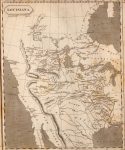
1804 Louisiana Map
-
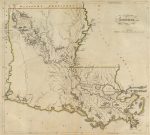
1814 Map of Louisiana
-
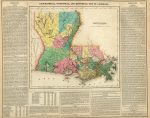
1822 Map of Louisiana
1822 Geographical, Historical, And Statistical Atlas Map Of Louisiana
-
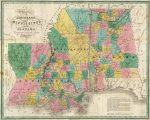
1827 Map of Louisiana
1827 Map of Louisiana, Mississippi, and Alabama
-
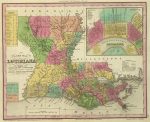
1836 Atlas Map of Louisiana
1836 A New Atlas Map Of Louisiana With Its Canals, Roads & Distances from place to place, along the Stage & Steam Boat Routes (with) New Orleans
-
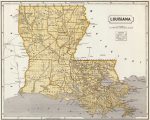
1845 Louisiana Map
-
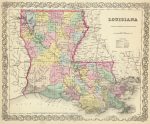
1856 Louisiana Map
-
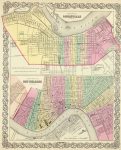
1856 Atlas Map of City Of New Orleans Louisiana
1856 City Of Louisville Kentucky. (with) The City Of New Orleans Louisiana Atlas Map
-
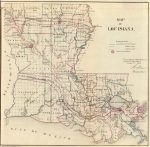
1866 Map of Louisiana
-
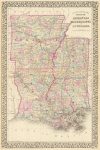
1880 Map of Louisiana
1880 County map of the states of Arkansas, Mississippi and Louisiana
-
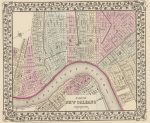
1880 Plan of New Orleans
D.O.T. Parish Road and Highway Maps of Louisiana
To View the Map: Just click the Image to view the map online. In order to make the Image size as small as possible they were save on the lowest resolution.
Louisiana Map Links
- Louisiana State Parks Map (mapofus.org)
- Louisiana Lakes and Rivers Map (mapofus.org)
- Louisiana Map With Cities and Highways (mapofus.org)
- Historical Maps of Louisiana (alabamamaps.ua.edu)
- Louisiana Digital Map Library (usgwarchives.net)
- Louisiana Maps, Atlases & Gazetteers (ancestry.com)
- Louisiana Maps – The Perry-Castañeda Library Map Collection (lib.utexas.edu)
- Louisiana State Museum Map Database (crt.state.la.us)
- U.S., Indexed County Land Ownership Maps, 1860-1918 (ancestry.com)
- American Memory Map Collection: 1500-2004 (memory.loc.gov)
- Louisiana State Museum Map Database (lsm.crt.state.la.us)
- Louisiana Map Books (amazon.com)

